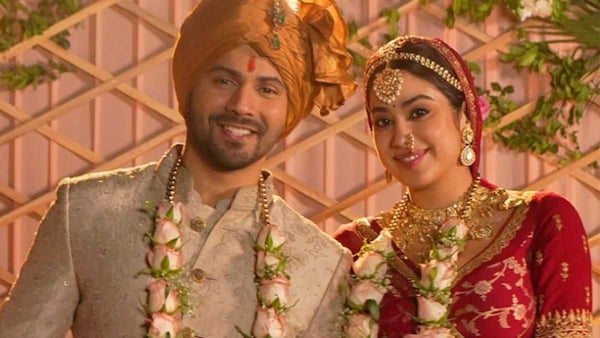Bawaal To Satyaprem Ki Katha, Hindi Cinema Is Rethinking How It Portrays Marriage
Divorce, abuse, trauma and incompatibility are only just finding their place in mainstream stories, writes Manik Sharma.

Last Updated: 02.24 PM, Aug 04, 2023
“Har relationship apne Auschwitz se guzarta hai (Every relationship goes through its own Auschwitz),” is a line spoken out loud in Prime Video’s Bawaal that is led by dependable actors like Varun Dhawan and Janhvi Kapoor. It’s a statement, the infamy of which will outlast anything the film set out to do through its awkward, offensive premise. It’s also the kind of allegorical trip you take without being sensitised to both history, and its traumatic context. But what Nitesh Tiwari’s film does, even while ingeniously trivialising genocide, is to underline the new place marriage now occupies in our storytelling. Far from the end to nefarious but life-affirming means, marriage is now a post-haven battleground where morality, stigma and trauma are not just being discussed, but also contested as the price one invisibly paid for the longest time, for happily-ever-afters.
That Hindi cinema has historically whipped pressure cooker love stories that whistle at the sight of mutual agreement, but disappear before interpersonal conflict, is established history. In its lifelong endeavour to offer hope and escape as opposed to cinematic social reckonings, Hindi cinema, at least its most popular romantic phase in the 90s, taught us one thing – the culmination of all societal, economic and existential angst is matrimonial bliss. It has obviously permeated into our social constitution, the unsaid rules of being and behaving like a ‘true Indian’. But almost every conservative idea has a sell-by date. As romantic stories struggle at the box office, Hindi cinema has understood that marriage itself has to be re-positioned, maybe even re-assessed for all the historic highs it has gotten away with.
In Dharma’s Jugg Jugg Jeeyo, not one but two couples evaluate the strained fabric of their respective relationships. One survives, but the other one — the one that has lasted longer and exhibited little tension — doesn’t. In Netflix’s Darlings, marriage becomes the enabler in a twisted, at times discomforting tale about toxicity’s benevolent face. In Tu Jhoothi Main Makkar, though the premise borrows from the model of pursuing companionship, marriage is framed as more than the mere interlocking of two conformists. It is seen as a difficult compromise, a jagged, cumbersome exercise in fitting into a square place. In the more recent Satyaprem Ki Katha, marriage becomes the starting point of excavating, haunting tales about personal trauma. In Bawaal, it becomes the mirror that a stubborn man must look into, to see past his ostentatious self.
Matrimonial contracts, whether literal or understood, dictate a lot in this country’s socio-political machinery. How caste and class are proliferated or cut across, is a direct consequence of the many ways we marry or don’t. It’s the baseline that punctuates economics as much as it accentuates the politics, and by extension power. In fact, it might be the clearest marker, of both segregation and preservation, of how the map society imagines for itself, is traced. Naturally, the intent with which people get together, makes it imperative to also study why and when they don’t despite wanting to. Alliance is instructional, whereas denial might be eye-opening. To this massive educational cue, Hindi cinema has persistently turned a blind eye. Marriage has usually been treated as a blanket of fog that hides conflict whether it is generational, cultural or gendered.
Divorce, abuse, trauma and incompatibility are only just finding their place in our stories. Moreover, they are being represented by mainstream cinema as the kind of conflict, our leading actors and actresses haven’t dealt with in the past. This is a prickly new space, where relationships, their sense of permanence, is questioned. Matrimony is no longer that destination that men and women youthfully yearn for. It has instead become that island of contempt, regret, even anger from where life’s many problems are contemplated and confronted. It’s like chewing up the scenery which Hindi cinema built for decades, the vagrant, dizzying juvenility of it casually being replaced by concerns and anxieties around careers, consent and more. Sure the woman are still belittled victims, the subject of the heroes’ evolving sense of etiquette. But continue down this path, and we’ll hopefully get to the point where divorce and separation become acceptable detours previously considered the narrative cliff, Hindi cinema ought not to wander near.
The fact that this gargantuan but candid shift in the way we package marriages, is happening in mainstream cinema, also says something about the point where the country’s population most affected, and maybe even infected by 90s’ marital fantasies, has come to. To a young India, in an age of swiping right on multiple prospects, the un-woke tradition of monogamously chasing a boxed identity probably feels unattractive. To those now familiar with the box, the complexity of its insides, has grown to pin our fantasies to a grounded reality. Marriage, much like anything else, is the beginning of a journey. It’s travelled in twos, but often also, fought and contested alone. At least Hindi cinema gets that bit last bit now.

 Premium
Premium